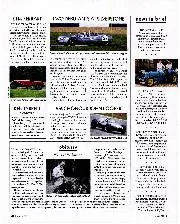
Two debutants at Silverstone
Frank Sytner unveiled his latest Cooper at Silverstone, the rare 1963 Cooper Monaco-Chevrolet. This is one of eight chassis shipped to the USA in 1963, six of which were given…
An Important Advance in Electrical Equipment. A FEW DETAILS OF THE NEW ” TUNGSTONE ” ACCUMULATOR.
WE have recently examined and tested one of the new ” Tungstone ” accumulators, the design of which includes so many notable features of an advanced character that we offer no apology placing some of the details before our readers.
Though this accumulator has only recently made its appearance, its development and perfection has involved years of research work, with the result that the manufacturers have succeeded in obviating the inconveniences usually associated with this part of the electrical equipment. Space does not permit of a full description of all the technical improvements relating to such points as the construction of the plates and the special methods of construction whereby the plates are die-cast and pasted with the necessary oxides by means of special machinery ; but we may mention that throughout the
entire construction the Tungstone accumulator is essentially an engineer’s job.
Perhaps the most outstanding feature from the private motorist’s point of view is the wonderful degree of accessibility provided by the design, an accessibility which hitherto has never been considered necessary by the accumulator manufacturer. In the ordinary course of events, when an accumulator develops a fault there is no chance of getting at the root of the trouble owing to the sealing of all the elements with insulating composition; but in the case of the Tungstone, it is possible to remove any of the plates for immediate inspection by the use of an ordinary spanner. Each of the two-volt cells is made as a separate unit, the terminals being bridged by die-cast connecting pieces, each of which is firmly secured in place by Vislok nuts. To remove any of the plates, it is only necessary to take off the terminals and lift the set out of its particular container. Each plate in the cell is held in
position by a split end which fixes in a leaden bridge and by closing the split ends, any of the plates can be taken out with great ease.
Ebonite spacers are used to separate the plates and thus no obstruction whatever is offered to the flow of electrolyte around the Tungstone plates.
The design of the accumulator will certainly appeal to car owners who are also wireless enthusiasts, for, if so desired, any of the two-volt units can be detached to use for the supply of valve filament current.
Another feature of this remarkable accumulator is the method adopted, whereby it is sent out from the works in a partially charged condition, though at the time of delivery it is void of acid. This means that the user can fill it with acid and put it direct on his car without going to all the trouble of the initial charge.
As a matter of fact, the accumulator will supply enough current for all the lamps before the dynamo does any charging, and it is even sufficiently strong to work the self-starter, but the latter test is not recommended in the usual way.
The construction naturally results in a slight increase in weight, but the advantages are so many that the few extra pounds in weight do not constitute any great objection.
We can recommend the Tungstone accumulator to our readers with the greatest of confidence and its installation should dispense with one of the greatest inconveniences with modern electric lighting and starting systems, i.e., the erratic behaviour of many forms of accumulator, especially after they have been used for a fairly long period.
It is understood that the manufacturers intend to produce a model suitable for motor-cycle lighting outfits, particulars of which will be announced in due course.